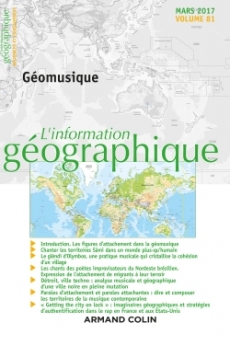
L'information géographique (1/2017)
Pour acheter ce numéro, contactez-nous
Recevez les numéros de l'année en cours et accédez à l'intégralité des articles en ligne.
La question spatiale est depuis longtemps un élément central dans les analyses portant sur le rap. Perçu comme émergeant dans des contextes urbains particuliers, ce genre musical donnerait à voir un fort ancrage, les rappeurs cherchant souvent à «représenter» leur ville ou leur région. Mais du domaine des représentations à celui des pratiques, c’est l’étude des espaces de la production musicale qui s’ouvre à partir de cas d’études pris, ici, à Lille et à Atlanta, rapprochant images préalables du lieu et stratégies de carrière.
Space has long been central to the analysis of rap music. Regarded as emerging from specific urban contexts, this genre is seen as conveying a strong spatial rootedness, as rappers are often willing to “represent” their city or region. On the contrary, this paper will show how they are constructed at the crossroad of different scales and contexts of practice. With case studies in Lille (France) and Atlanta (United States), I will observe how these representations are shaped both by pre-existing images of place and by strategies carried out by rappers, with the aim of asserting their authenticity.

